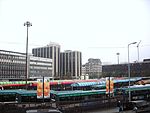The Millennium Stadium (Welsh: Stadiwm y Mileniwm), known since 2016 as the Principality Stadium (Welsh: Stadiwm Principality) for sponsorship reasons, is the national stadium of Wales. Located in Cardiff, it is the home of the Wales national rugby union team and has also held Wales national football team games. Initially built to host the 1999 Rugby World Cup, it has gone on to host many other large-scale events, such as the Tsunami Relief Cardiff concert, the Super Special Stage of Wales Rally Great Britain, the Speedway Grand Prix of Great Britain and various concerts. It also hosted FA Cup, League Cup and Football League play-off finals while Wembley Stadium was being redeveloped between 2001 and 2006, as well as football matches during the 2012 Summer Olympics.
The stadium is owned by Millennium Stadium plc, a subsidiary company of the Welsh Rugby Union (WRU). The architects were Bligh Lobb Sports Architecture. The structural engineers were WS Atkins and the building contractor was Laing. The total construction cost of the stadium was £121 million, of which the Millennium Commission funded £46 million.The Millennium Stadium opened in June 1999 and its first major event was an international rugby union match on 26 June 1999, when Wales beat South Africa in a test match by 29–19 before a crowd of 29,000. With a total seating capacity of 73,931, it is the largest stadium in Wales and the fourth largest (and second largest outside London) in the United Kingdom by total capacity. In addition, it is the third-largest stadium in the Six Nations Championship behind the Stade de France and Twickenham. It is also the second-largest stadium in the world with a fully retractable roof and was the second stadium in Europe to have this feature. Listed as a category four stadium by UEFA, the stadium was chosen as the venue for the 2017 UEFA Champions League Final, which took place on 3 June 2017. In 2015, the Welsh Rugby Union announced a 10-year sponsorship deal with the Principality Building Society that saw the stadium renamed as the "Principality Stadium" from early 2016.








